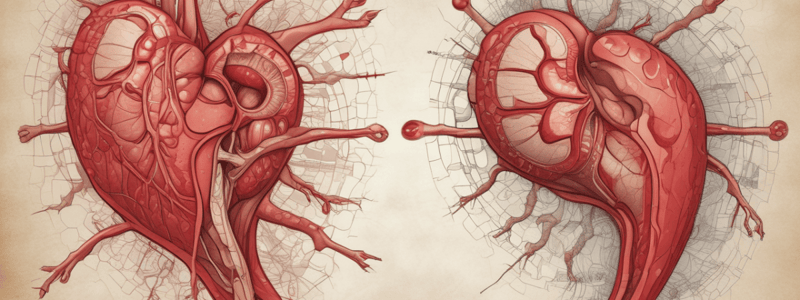Podcast
Questions and Answers
What is the result of endothelial cell injury and dysfunction in atherosclerosis?
What is the result of endothelial cell injury and dysfunction in atherosclerosis?
- Increased vascular permeability (correct)
- Smooth muscle cell recruitment
- Decreased vascular permeability
- T-cell activation
What is the composition of fatty streaks in atherosclerosis?
What is the composition of fatty streaks in atherosclerosis?
- Platelets and lipoproteins
- Foam cells and collagen
- Lipid-filled foamy macrophages (correct)
- Lipid-filled smooth muscle cells
What is the role of PDGF in atherosclerosis?
What is the role of PDGF in atherosclerosis?
- Activate T-cells
- Induce smooth muscle cell death
- Inhibit smooth muscle cell proliferation
- Induce smooth muscle cell recruitment and proliferation (correct)
What is a complication of atherosclerosis?
What is a complication of atherosclerosis?
What is a characteristic of atherosclerotic plaques?
What is a characteristic of atherosclerotic plaques?
What is a risk factor for atherosclerosis?
What is a risk factor for atherosclerosis?
What is the critical percentage of luminal cross-sectional area decrease that typically occurs in atherosclerotic stenosis?
What is the critical percentage of luminal cross-sectional area decrease that typically occurs in atherosclerotic stenosis?
Which cell type is a component of atherosclerotic plaques?
Which cell type is a component of atherosclerotic plaques?
What is the consequence of atherosclerotic plaque rupture?
What is the consequence of atherosclerotic plaque rupture?
What is the main component of the extracellular matrix in atherosclerotic plaques?
What is the main component of the extracellular matrix in atherosclerotic plaques?
What is the term for the formation of a new blood vessel within an atherosclerotic plaque?
What is the term for the formation of a new blood vessel within an atherosclerotic plaque?
What is the term for the accumulation of lipids within atherosclerotic plaques?
What is the term for the accumulation of lipids within atherosclerotic plaques?
What is the consequence of atherosclerosis-induced pressure or ischemic atrophy of the underlying media?
What is the consequence of atherosclerosis-induced pressure or ischemic atrophy of the underlying media?
What is the term for the narrowing of the vessel lumen due to atherosclerotic plaques?
What is the term for the narrowing of the vessel lumen due to atherosclerotic plaques?
What is the term used to describe the hardening of the arteries?
What is the term used to describe the hardening of the arteries?
What is the characteristic of atherosclerotic plaques?
What is the characteristic of atherosclerotic plaques?
What is the result of the rupture of an atherosclerotic plaque?
What is the result of the rupture of an atherosclerotic plaque?
What is the underlying condition of coronary, cerebral, and peripheral vascular disease?
What is the underlying condition of coronary, cerebral, and peripheral vascular disease?
What is the result of atherosclerotic plaques enlarging?
What is the result of atherosclerotic plaques enlarging?
What is the consequence of atherosclerotic plaques increasing the diffusion distance from the lumen to the media?
What is the consequence of atherosclerotic plaques increasing the diffusion distance from the lumen to the media?
What is the term used to describe the lesions that impinge on the vascular lumen and can rupture to cause sudden occlusion?
What is the term used to describe the lesions that impinge on the vascular lumen and can rupture to cause sudden occlusion?
What is the location of the arteries affected by atherosclerosis?
What is the location of the arteries affected by atherosclerosis?
Flashcards are hidden until you start studying
Study Notes
Atherosclerosis
- Atherosclerotic plaques have three components: cells (smooth muscle cells, macrophages, and T cells), extracellular matrix (including collagen), and intracellular and extracellular lipid.
- Atherosclerotic plaques can gradually occlude vessel lumina, compromising blood flow and causing ischemic injury.
Morphology
- Atherosclerotic plaques consist of a central lipid core, a fibrous cap, and a residual lumen.
- Inflammation, calcifications, and neovascularization are common features of atherosclerotic plaques.
Atherosclerosis Consequences
- Atherosclerotic stenosis: narrowing of the lumen, causing ischemic injury, typically occurs when the occlusion produces a 70% decrease in luminal cross-sectional area.
- Rupture, ulceration, and erosions: exposing highly thrombogenic plaque constituents (collagen), which can lead to hemorrhage, atheroembolism, and aneurysm formation.
- Atheroembolism: plaque rupture can discharge atherosclerotic debris into the bloodstream, producing microemboli that can block distant arteries.
- Aneurysm formation: atherosclerosis-induced pressure or ischemic atrophy of the underlying media, with loss of elastic tissue, causes weakness and potential rupture.
Pathogenesis
- Endothelial cell injury and dysfunction cause increased vascular permeability, leukocyte and platelet adhesion, and inflammation.
- Injured endothelial cells allow the accumulation of lipoproteins, leading to monocyte migration into the intima and transformation into macrophages and foam cells.
- Smooth muscle cells produce extracellular matrix (collagen) and inflammatory cytokines, which activate T-cells.
- PDGF (from activated platelets, macrophages, endothelial cells, and smooth muscle cells) induces smooth muscle cell recruitment and proliferation.
Morphology – Fatty Streaks
- Fatty streaks: composed of lipid-filled foamy macrophages, beginning as multiple minute flat yellow spots, eventually coalescing into elongated streaks 1 cm long or longer.
Arteriolosclerosis
- Arteriosclerosis: hardening of the arteries, a generic term reflecting arterial wall thickening and loss of elasticity, with distinct clinicopathologic conditions: atherosclerosis, arteriolosclerosis, and Mönckeberg medial sclerosis.
Atherosclerosis
- Characterized by intimal lesions called atheromas (or atheromatous or atherosclerotic plaques) that impinge on the vascular lumen and can rupture to cause sudden occlusion.
- Involves medium-sized to large arteries and underlies the pathogenesis of coronary, cerebral, and peripheral vascular disease.
Studying That Suits You
Use AI to generate personalized quizzes and flashcards to suit your learning preferences.




